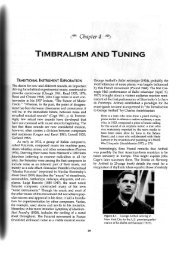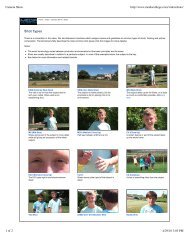ExpERIMENTALISM - Margaret Noble
ExpERIMENTALISM - Margaret Noble
ExpERIMENTALISM - Margaret Noble
Create successful ePaper yourself
Turn your PDF publications into a flip-book with our unique Google optimized e-Paper software.
Experimentalism 107a stopwatclr, Tudor covered the piano keyboard at thebeginning of each movement, playrng nothing, buttiming the movements marked by Cage in the otherwiseblank score (movements of one minute, forty seconds;two minutes, twenty-three seconds; and thirtyseconds respectively). Unfortunately, the brilliance ofTudor's dramatic performance had the adverse effectof limiting this work to piano (the score reads "for anyinstrument or combination of instruments"). Virtuallyany sound or combination of sounds with a total durationof four minutes and thirty-three seconds will successfullyrcalize the score, from thinking-in-a-bathtubto silence by a symphony orchestra. Cage has clarifiedthe concept behind such works:. where it is realized that sounds occurwhether intended or not, one tums in the directionof those he does not intend. The turning ispsychological and seems at first to be a givingup of everything that belongs to humanity-fora musician, the giving up of music. This psychologicalturning leads to the world of nature,where, gradually or suddenly, one sees thathumanity and nature, not separate, arq in thisworld together; that nothing was lost wheneverything was given away. In fact, everythingis gained. (Cage 1961, p.8)Rauschenberg's White Paintings link further with4'33' tn that the White Paintings involve the shadowsof spectators, variance of lights, reflections, and so onwhich tum the seeminglyblank canvas into a counterpointof visual activity. In 4'33", the coughs, laughter,and other audible movements of the audience as wellas extraneous sounds become, in fact, the work. Lrboth cases the creator has produced a concepfual workof art (Gaburo 1975; Johnson1974; Knowles 1976).La Monte Young's concept music includes Composition1960 #Z which contains onlv the notes B and F#with the instructions: to be held for a "long time."Composition 1960 #10 requests that the performer"draw a straight line and follow it." In 1960, at Berkeley,Young presented a composition that consisted oftuming loose a jar full of butterflies on an unsuspectingaudience. Other compositions of 1960 include hisfamous line piece:My Composition 1960 No. 9 consists of a straightline drawn on a piece of paper. It is to be performedand comes with no instructions. Thenight I met Jackson Maclow we went down tomy apartment and he read some of his poemsfor us. Later when he was going home, he saidhe'd write out directions to get to his place sowe could come and visit him sometime. He happenedto pick up "Composition No. 9" and said,"Can I write it here?" I said "No, wait, that's apiece. Don't write on that." He sai4 "Whadayamean a piece? That's just a line." (Young andZazeela L969)Karlheinz Stockhausen's Mikrophonie L (1964) usesonly one sound source, a large tam-tam upon whichperformers manipulate the various verbal instructionsof the score, "scraping, trumpeting" and so on.Eric Andersen's Opus 48 ("Which tums anonymouswhen the instruction is carried out") is sentthrough the mail on a piece of cardboard that states intotal: "Place the chosen tautology." Tom Johnsory inhis book Imaginary Music, includes a number ofunplayable concept pieces (Johnson 1974).His CelestialMusicfor ImaginaryTrumpets, shown in Figure 6.4,cannotbe performed but only conceptualized or imagined.Robert Moran's Compositionfor Piano with Pianiststates: "A pianist comes onto the stage and goesdirectly to the concert grand piano. He climbs into thepiano, and sits on the strings. The piano plays him"(Moran 1973,p. M).Accidents (196nby Larry Austin contains instructionsfor the pianist to perform the music without creatingactual sounds. The required speed of performancemakes accidents unavoidable. As if repenting,performers must retum to each gesture in whichan accident occurred (i.e., a sound made) and repeat ituntil error-free (silence).The German-originated but often New York-basedmovement Fluxus (which included Paik, Young DickHiggins, Eric Andersen, Thomas Schmidt, JacksonMaclow, and George Brecht) led the conceptual artlmusic movement for a number of years, finallybecoming a publisher of art objects. E*pty objectsprovided the objectives in the experiments of thesecomposers/ poets/ and artists. Often their works do notcontain hints of intended action or what materials touse (Osterreich 1977; Zimmerman 1976). Figure 6.5shows George Maciunas's view of the Fluxus artmovement. The references to "Spikes (sic) Jones" andDuchamp suggest the levity that many members ofthe group felt about their projects. Figures 6.6 and 6.7provide photo documentation of some of the membersof Fluxus. Other individuals involved (but not shownhere) included Jonas Mekas, Bob Watts, Ben Pattersoryand Joe Jones.Text sound music is based on the textljud kompositioneroI two Swedish composers, Lars4unnar Bodinand Bengt-Emil Johnson in 1966. Termed soundpoetry, speech music, and even lexical music, its originsextend back to the Futurists (in Italy) just after thetum of the century. Works in this genre expand toinclude reading and speaking as music by using ono-




